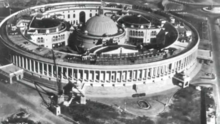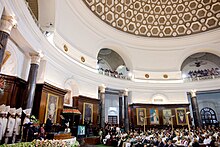

| Old Parliament House | |
|---|---|
Samvidhan Sadan
| |

Old Parliament House, seen from Kartavya Path
| |
|
| |
| Former names |
|
| General information | |
| Status | Retired and waiting for heritage restoration |
| Type | Heritage |
| Architectural style | Lutyens' Delhi |
| Location | New Delhi |
| Address | Sansad Marg, New Delhi, National Capital Territory of Delhi |
| Town or city | New Delhi |
| Country | |
| Coordinates | 28°37′02″N 77°12′29″E / 28.6172°N 77.2081°E / 28.6172; 77.2081 |
| Current tenants | Museum |
| Groundbreaking | 1921 by The Duke of Connaught and Strathearn |
| Construction started | 1921 |
| Completed | 18 January 1927 |
| Opened | 18 January 1927 by The 1st Baron Irwin, Viceroy of India |
| Owner | Government of India |
| Design and construction | |
| Architect(s) |
|
| Other information | |
| Seating capacity | 790 |
| Public transit access | |
The Old Parliament House, officially known as the Samvidhan Sadan (Constitution House),[1][2] was the seat of the Imperial Legislative Council of India between 18 January 1927 and 15 August 1947, the Constituent Assembly of India between 15 August 1947 and 26 January 1950, and the Parliament of India between 26 January 1950 and 18 September 2023. For 73 years, it housed the Lok Sabha and the Rajya Sabha (the lower and upper houses) respectively in India's bicameral parliament.
The building was designed by British architects Edwin Lutyens and Herbert Baker and was constructed between 1921 and 1927. It was opened in January 1927 as the seat of the Imperial Legislative Council and was known as the Council House.[3] Following the British withdrawal from India, it was taken over by the Constituent Assembly of India, and then by the Indian Parliament once India's Constitution came into force on 26 January 1950 with India becoming a republic.[4]
The New Parliament House, built near this building on a triangular plot from 2020 to 2023 was inaugurated on 28 May 2023. It was built as part of the Indian government's Central Vista Redevelopment Project.

The building was designed by the British architects Sir Edwin Lutyens and Sir Herbert Baker in 1912–1913.[5] The structure was built over a period of six years, starting in 1921 and culminating in 1927. Following the Montagu-Chelmsford Reforms in 1919, there was an expansion of the Legislative Assembly which necessitated the construction of the building.[6] The iconic circular design was proposed by Lutyens, who believed that this would be the most efficient design given the triangular shape of the plot of land on which the building is located.[7]
The foundation stone was laid by HRH Prince Arthur, Duke of Connaught and Strathearn, in February 1921. On 18 January 1927, Sir Bhupendra Nath Mitra, a Member of the Governor-General's Executive Council, in charge of the Department of Industries and Labour, invited Lord Irwin, then Viceroy of India, to inaugurate the building. The third session of Central Legislative Assembly was held in this building on 19 January 1927.[8][9]
After independence, the house served as the seat of the Constituent Assembly from 1947–1950. The Constitution of India was created here, under the presidency of Rajendra Prasad.[10]

Two floors were added to the structure in 1956 due to a demand for more space.[11]
The Parliament Museum, which was opened in 2006, stands next to the Parliament House, in the building of the Parliamentary Library.[12]
The architectural style of the structure can be described as an amalgamation of a classical style of architecture inspired from Greece and Rome and structural elements and decorative motifs from Indian architecture.[13] The perimeter of the building is circular, with 144 columns on the outside. At the centre of the building is the circular Central Chamber, and surrounding this Chamber are three semicircular halls that were constructed for the sessions of the Chamber of Princes (now used as the Library Hall), the State Council (later used for the Rajya Sabha), and the Central Legislative Assembly (later used for the Lok Sabha). The former parliament is surrounded by large gardens and the perimeter is fenced off by sandstone railings (jali).[14] The current building is planned to be converted into a Museum of Democracy after the new Parliament House becomes operational.[15]
Proposals for a new parliament building to replace Parliament House emerged in the early 2010s as a result of questions being asked about the stability of the original structure.[16] In 2012, a committee was assembled by the then Speaker, Mira Kumar, to suggest and assess several alternatives to the usage of the building.[17]
In 2019, the Indian government launched the Central Vista Redevelopment Project, a multi-billion dollar project to redevelop the Central Vista, India's central administrative area near Raisina Hill, New Delhi. The construction of a new parliament building, as well as redeveloping the Rajpath will create a new office and residence for the Indian prime minister, as well as combining all ministerial buildings in a single central secretariat.[18]
The groundbreaking ceremony for the new building was held in October 2020 and the foundation stone was laid on 10 December 2020.[19][20]

After the inauguration of the New Parliament House, the Old Parliament House will be converted to a Museum of Democracy.[21] In a speech held on 19 September 2023, Prime Minister Narendra Modi proposed that the building be renamed Samvidhan Sadan ("Constitution House").[22] Speaker of the Lok Sabha, Om Birla, announced later that day that it had been so renamed.[23]
On 13 December 2001, five terrorists from Lashkar-e-Taiba (LeT) and Jaish-e-Mohammed (JeM) - two Pakistan-raised terrorist organisations - entered the grounds of Parliament and attempted to invade the building. They were all killed outside the building. The attack led to the deaths of six Delhi Police personnel, two Parliament Security Services personnel, and a gardener – nine others in total – and led to increased tensions between India and Pakistan, resulting in the 2001–02 India–Pakistan standoff.[24]
|
| |||||||||||||||||||
|---|---|---|---|---|---|---|---|---|---|---|---|---|---|---|---|---|---|---|---|
| Topics |
| ||||||||||||||||||
| History |
| ||||||||||||||||||
| Government and administration |
| ||||||||||||||||||
| Places of interest |
| ||||||||||||||||||
| Geography and divisions |
| ||||||||||||||||||
| Transport |
| ||||||||||||||||||
| Sports |
| ||||||||||||||||||
| Culture |
| ||||||||||||||||||
| Other templates |
| ||||||||||||||||||
| Related |
| ||||||||||||||||||
| |||||||||||||||||||